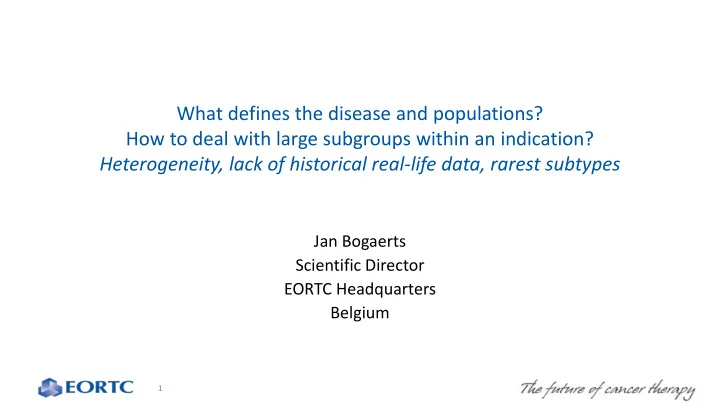

What defines the disease and populations? How to deal with large subgroups within an indication? Heterogeneity, lack of historical real-life data, rarest subtypes Jan Bogaerts Scientific Director EORTC Headquarters Belgium 1
Disclosures • EORTC works with many pharma companies, but is an independent research infrastructure. • I am a member of the EMA SAG-O. 2
Summary • Heterogeneity questions – a perspective • An example basket trial from EORTC • Questions in performing a basket trial • Questions in the setting of agnostic indications • What can be done in the situation of data scarcity 3
Conceptual model (very unsatisfactory) Tumor Type Breast Cancer Colon Cancer Lung Cancer … Marker HER 2 expression ER positive Some Immuno marker others … 4
“Classical” trial: tumor type (with stage, eligibility criteria …) Tumor Type Breast Cancer Colon Cancer Lung Cancer … Marker HER 2 expression ER positive Some Immuno marker others … 5
Normal questions to statisticians: • Do we know this treatment works equally effectively in all these patients? • Answer: probably not • Approach (more than solution): • Stratify for potential confounders • Check within plausible subgroups • Interaction tests (typically underpowered) • This is checking that nothing strange is ongoing with regards to heterogeneity of the treatment effect: “justify that we do not need to split” • In a situation where the base assumption is that there is homogeneity (because of histology/anatomy) 6
Targeted agent, trial Tumor Type Breast Cancer Colon Cancer Lung Cancer … Marker HER 2 expression ER positive Some Immuno marker others … 7
“Umbrella trial” Tumor Type Breast Cancer Colon Cancer Lung Cancer … Marker HER 2 expression ER positive Some Immuno marker others … 8
“Basket trial”, ask the same/similar question across tumor types Tumor Type Breast Cancer Colon Cancer Lung Cancer … Marker HER 2 expression ER positive Some Immuno marker Marker X … 9
Important to understand: • In any statistical framework, one assumes that answers coming out of the experiment are applicable to all individuals in the sample • One requires / assumes some sufficient degree of ‘sameness’ amongst the eligible patients • We are aggregating data from individuals, and learning about the group as a whole, using techniques to exclude good/bad luck • This assumption is very much under discussion now, as the “cells” for cancer research become smaller and smaller 10
The heterogeneity question • In the basket trial situation, the heterogeneity question must be addressed: • By science • Preclinical • Driver mutation • Alternative pathways • … • … and then by statistics 11
90101 : CR oss-tumoral phase II clinical trial E xploring Crizotinib in patients with A dvanced T umours induced by causal alterations of E ither ALK or MET (" CREATE ") 6 parallel phase II in Marker + each with a Simon 2- stage design on response rate ( RR ) (P0=10%, P1=30%; α = β =0.10) PI: P. Schoeffski 12
13
Basket trials: comments • Pragmatic: many in one • Submitting, writing, initiating a CT is resource intensive • Typically, we feel fairly free to learn across baskets for safety signals • Accrual will be (very) different • In each of these baskets: • We may have a different design, a (somewhat) different question • It is possible that endpoints are varied between baskets • Thresholds for what is considered success may vary depending on tumor type, all within the same basket trial • One could also envisage total tumor type agnostic approach: no baskets, “everyone” with the marker 14
In a nutshell, CREATE • Went for a ‘humble’ approach: • Each tumor type is interpreted and reported separately • No alpha control across the board (because no such interpretation planned) • The rationale for the trial is that these are rare subsets, with a drug that appear to have promise in these rare subsets • Compare this to doing each trial separately, and the huge admin cost (at EORTC, at least) 15
Model-Free 2-Stage Design Cunanan, Iasonos, Chen et al, Stats in Medicine 2017 For me this starts being valid only if the science has been done One can not conclude homogeneity only on the numbers This one is “justify that we can merge” 16
The setting of agnostic indications • Very high need of upfront science to address credible pathway, essential to the tumor, no alternative pathways, etc. • Question of representation of tumor types within the data: is there a minimum? • Such indication(s) will even increase the need for better real-life data, real-life follow-up. • The used statistic may become even more of a potential confusing factor: hazard ratios, response rates, odds ratios • Baseline risks and prognoses may be rather different across tumor types • A basket is not the same as a stratum 17
Data scarcity (my insufficient thoughts) • Missing historical data • This … increases the rationale for randomization • (very) small marker positive subgroups (across tumor types) • Need for broad screening platforms that direct patients into the right trial • Raises the idea of umbrella X basket • Increases the need for more efficient and impactful real life data collection Data scarcity should lead us to double down on methodology, rather than try to omit it 18
Thanks to • People at EORTC statistics department • Laurence Collette • Vassilis Golfinopoulos • Sandra Collette • Olivier Collignon at EMA 19
Thank you 20
Recommend
More recommend